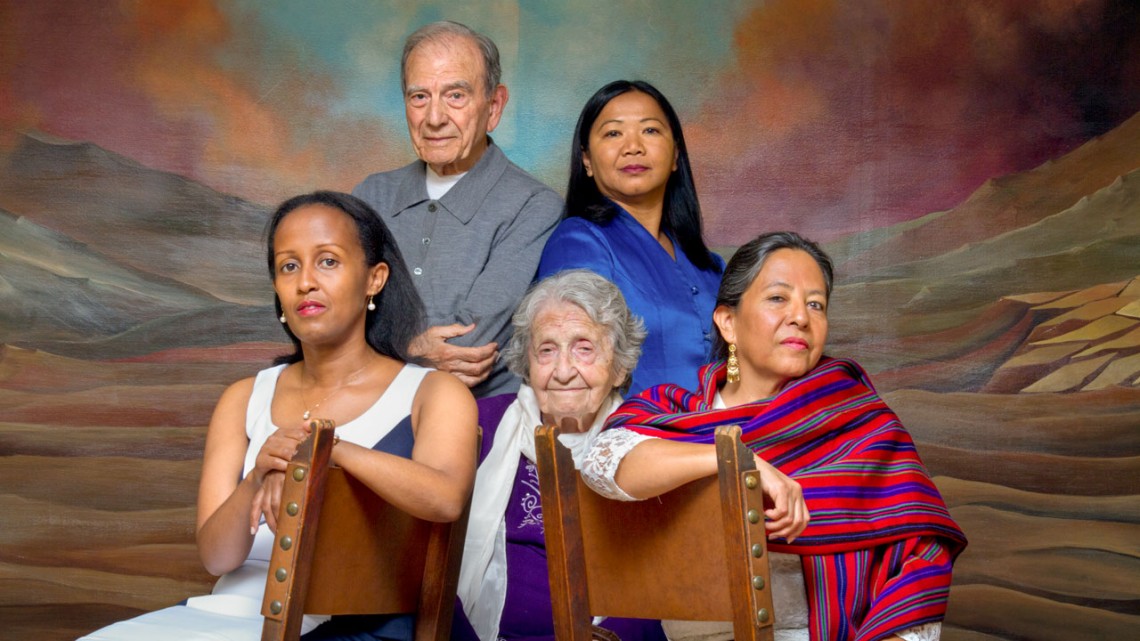
A photo from USC Shoah Foundation's Visual History Archive, of witnesses of different acts of genocide. Left to right: Edith Umugiranez, from Rwanda; Dario Gabbai, who survived the Holocaust; Yevigne Salibian, from Armenia; Aracely Garrido, from Guatemala; Sara Pol-Lim, from Cambodia.
Witnesses and survivors of the Holocaust and other acts of genocide are dwindling in numbers, but their faces and voices will live on through Cornell University Library's recently acquired permanent access to USC Shoah Foundation's Visual History Archive (VHA).
Spanning 65 countries and 43 languages, the audiovisual archive includes 55,000 firsthand accounts of genocide – from the Jewish Holocaust to the massacre of Armenians; from the atrocities against the Rohingya in Myanmar to the civil war in South Sudan.
"The Visual History Archive is a massive resource for research and teaching, but it should not be thought of only as a repository of victims' experiences of genocide," said Jonathan Boyarin, the Mann Professor of Modern Jewish Studies in the College of Arts and Sciences, and director of the Jewish Studies Program. "It is also a repository of the full lives they lived before and after these events."
Magnus Fiskesjö – an associate professor of anthropology in the College of Arts and Sciences who was awarded a teaching fellowship by USC Shoah Foundation – uses the archive to teach ANTHR 3552, Genocide Today, a class studying examples from the past to examine current atrocities against ethnic minorities in Myanmar and China.
Because the video testimonies in the archive have been thoroughly indexed, Fiskesjö's students can use keyword searches to explore various topics.
"The archive provides research materials for several different angles on genocide," he said, including the conditions and warning signs of atrocities, the complex relationship between memory and trauma, and the tensions between national and ethnic identities that can lead to violence against minorities.
Fiskesjö said testimonies also have a potential to be used as evidence in the International Criminal Court.
"I speak to my class about the importance of not letting perpetrators get away with what they've done," he said, "because that paves the way for the next genocide."
Patrick J. Stevens, curator of the Fiske Icelandic Collection and a Judaica bibliographer who coordinated the acquisition of the archive, said the VHA's testimonies also serve as powerful reminders.
"Living witnesses are becoming fewer, whether it's Jews who experienced the Holocaust or the indigenous peoples who suffered under oppression in Guatemala," he said. "At the same time, we have upcoming generations who may not know about these genocidal acts. And if they don't know, how can they work to try to prevent these events from happening again?"
The library first gained access to the Visual History Archive in 2015, with philanthropic support from Betsy and Philip Darivoff. A portion of the funds they provided to the Jewish Studies Program and a recent gift from Steven Chernys '83 – a supporter of Jewish collections and a decadeslong donor to Cornell University Library – funded permanent access to the VHA.
Other alumni have been vital to building the archive and providing access to the Cornell community.
Jose Beduya is a staff writer, editor and social media coordinator for Cornell University Library.

No comments:
Post a Comment